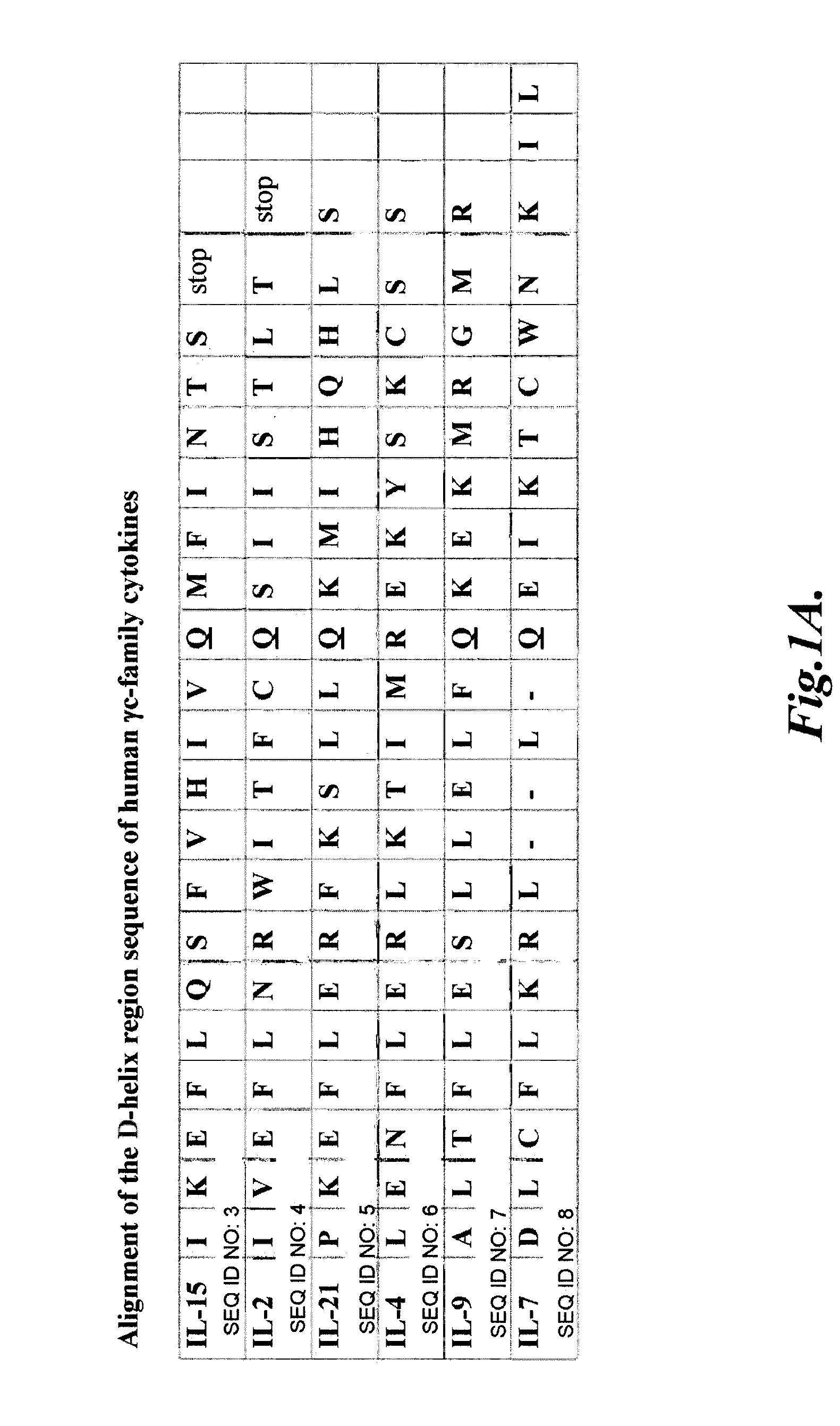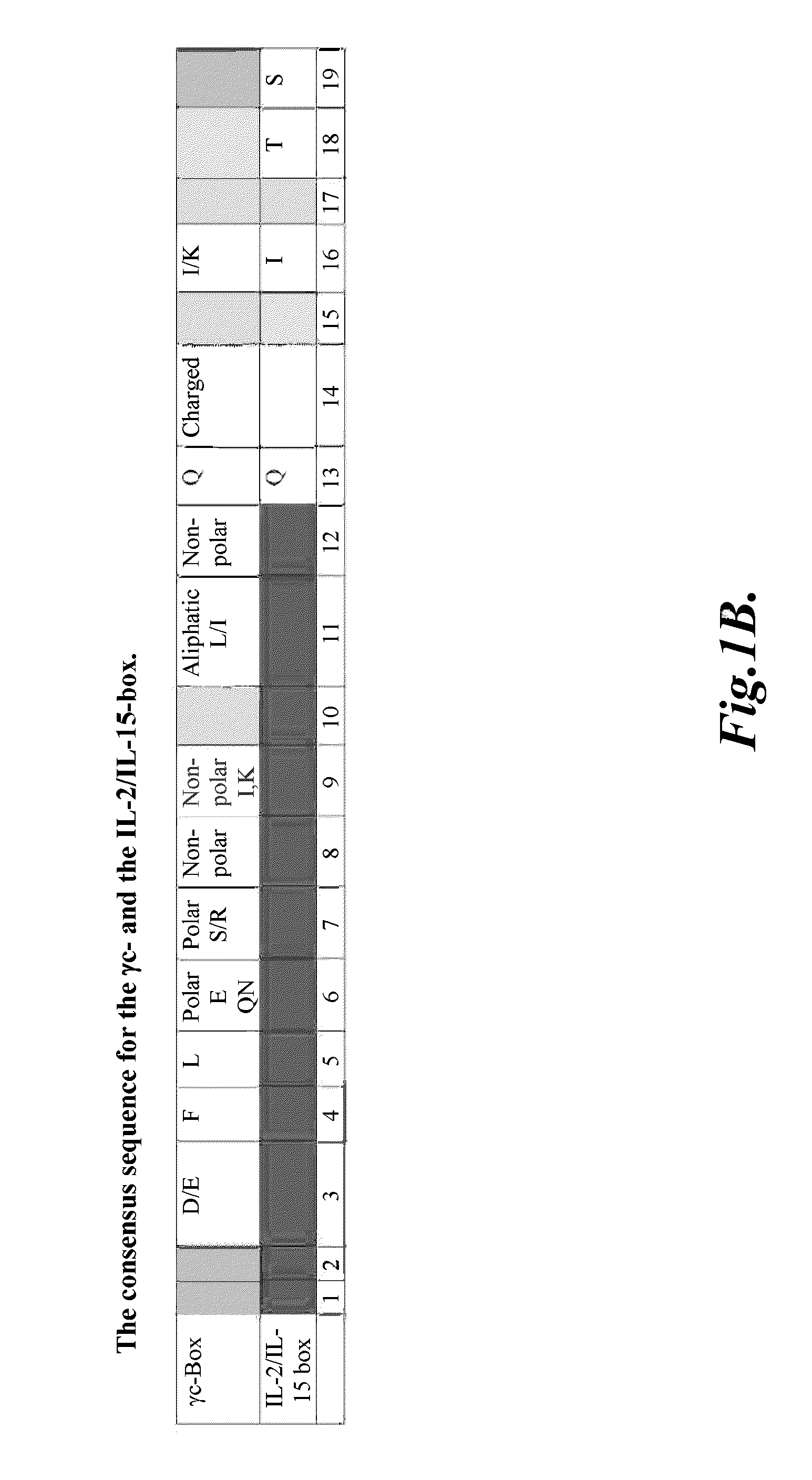Compositions and methods for modulating gamma-c-cytokine activity
a gamma-c-cytokine and activity technology, applied in the field of peptide antagonists of the cfamily cytokines, can solve the problems of difficult approach, monoclonal anti-receptor antibodies, and ineffective treatment of cytokine-implanted human diseases, and achieve the effect of improving biological stability in vivo and efficient delivery
- Summary
- Abstract
- Description
- Claims
- Application Information
AI Technical Summary
Benefits of technology
Problems solved by technology
Method used
Image
Examples
example 1
Method for Assessing the Inhibitory Activity of γc-Antagonist Peptide
[0105]The capacity of any custom derivative peptide prepared according to the present embodiments for inhibiting the action of one γc-cytokine family member is determined using mammalian cellular assays to measure their proliferative response to the γc-cytokine family member.
[0106]For each of the six γc-cytokines, indicator cell lines: CTLL-2, a murine CD8 T cells line available from American Type Culture Collection, and PT-18, a murine mast cell line and its subclone PT-18β, is transfected with human IL-2β gene to make the cells responsive to IL-2 and IL-15 (Tagaya et al., 1996, EMBO J. 15:4928-39), and is used to quantitatively determine the γc-cytokine's growth-promoting activity (See Current protocols in Immunology from Wiley and Sons for a methodological reference). The indicator cells demonstrate semi-linear dose-dependent response when measured by a colorimetric WST-1 assay over a range of concentrations (Se...
example 2
BNZ-γ Peptide Specifically Inhibits the Growth-Promoting Activities of IL-9 and IL-15
[0107]Using PT-18β cells as described above, the ability of the BNZ-γ peptide to specifically inhibit the growth-promoting activity of select γc-cytokines was determined (FIG. 3A). IL-3, a non-γc-cytokine that supports the growth of PT-18β cells, was used as a negative control. Briefly, PT-18β cells were incubated either with two different dilutions of BNZ-γ peptide produced by HEK293T cells (1:20 or 1:50 dilution of the original supernatant of HEK293T cells transfected with a BNZ-γ expression construct) or without BNZ-γ peptide in the presence of IL-3, IL-9, IL-15, or IL-4 (1 nM of each cytokine in the culture). The growth-responses of the cells were determined 2 days after the introduction of BNZ-γ peptide and the cytokine using the WST-1 assay. The growth-promoting activity of IL-3 (a non γc-cytokine) was not inhibited by BNZ-γ. In contrast, the activity of IL-15 and IL-9 were significantly (p<0....
example 3
Method for Measuring Activity by Assaying 3H-thymidine Incorporation of as a Marker of Cellular Proliferation
[0109]Inhibition of γc-cytokine-induced proliferation of an indicator cell population by antagonist custom derivative peptides is measured by the 3H-thymidine incorporation assay. Briefly, radiolabeled thymidine (1 microCi) is given to 20-50,000 cells undergoing proliferation in the presence of cytokines. The cell-incorporated radioactivity is measured by trapping cell-bound radioactivity to a glass-fiber filter using a conventional harvester machines (Example, Filtermate Universal Harvester from Perkin-Elmer), after which the radioactivity is measured using a b-counter (Example 1450, Trilux microplate scintillation counter).
PUM
| Property | Measurement | Unit |
|---|---|---|
| concentration | aaaaa | aaaaa |
| concentration | aaaaa | aaaaa |
| concentration | aaaaa | aaaaa |
Abstract
Description
Claims
Application Information
 Login to View More
Login to View More - R&D
- Intellectual Property
- Life Sciences
- Materials
- Tech Scout
- Unparalleled Data Quality
- Higher Quality Content
- 60% Fewer Hallucinations
Browse by: Latest US Patents, China's latest patents, Technical Efficacy Thesaurus, Application Domain, Technology Topic, Popular Technical Reports.
© 2025 PatSnap. All rights reserved.Legal|Privacy policy|Modern Slavery Act Transparency Statement|Sitemap|About US| Contact US: help@patsnap.com



